- Center on Health Equity & Access
- Clinical
- Health Care Cost
- Health Care Delivery
- Insurance
- Policy
- Technology
- Value-Based Care
Validation of the FINE-CKD Model for Future Health Technology Assessments for Finerenone in Patients With Chronic Kidney Disease And Type 2 Diabetes
ABSTRACT
BACKGROUND: The FINE-CKD model was developed to estimate the cost-effectiveness of finerenone in patients with chronic kidney disease (CKD) and type 2 diabetes (T2D).
OBJECTIVE: To perform internal and external validation by comparing the model estimates with trial results and outcomes from other models.
METHODS: Incidence rates from trials were compared with the model predictions. Statistical tests were then performed to assess whether modeled event rates aligned with trial observations. A cross-validation was also performed using the online version of the SHARP CKD-Cardiovascular Disease (SHARP CKD-CVD) model, with population characteristics from the finerenone trials analyzed. Where no finerenone data were available, the default SHARP CKD-CVD values were used. Comparison of the results considered the ranges from both models.
RESULTS: The outcomes of the FINE-CKD model reflect the event rates observed in the trials. Based on the results of the statistical tests, the hypothesis of no difference between observed and modeled events cannot be rejected for any of the outcomes. The results of the FINE-CKD model are within the ranges from the SHARP CKD-CVD model. Disease progressions align across the models; however, incident kidney failure events in the SHARP CKD-CVD model were higher. This can be explained by simulation of more severely affected patients in the SHARP CKD-CVD model.
CONCLUSIONS: This study demonstrates that the FINE-CKD model adequately reflects the clinical data and provides reliable extrapolation relative to the existing predictive tools while also being conservative in its approach.
Am J Manag Care. 2022;28:S104-S111. https://doi.org/10.37765/ajmc.2022.89212
Chronic kidney disease (CKD) is progressive and irreversible, causing gradual loss of kidney function that may lead to kidney failure (end-stage kidney disease [ESKD]). CKD is often associated with type 2 diabetes (T2D), which causes gradual and irreversible loss of kidney function that substantially impacts both mortality and morbidity.1 The key morbidity burden in these patients is associated with progression to ESKD and risk of cardiovascular (CV) events.1 These risks increase with kidney function loss, albuminuria and particularly both biomarker findings and are associated with increased mortality and reduced quality of life.2-4 The international Kidney Disease: Improving Global Outcomes (KDIGO) 2012 Clinical Practice Guideline for CKD Evaluation and Management, endorsed in the United States by the Kidney Disease Outcomes Quality Initiative,5 describe a cause-glomerular filtration rate-albuminuria (C-G-A) CKD definition and classification to detect CKD and stratify risk based on the estimated glomerular filtration rate (eGFR) and urine albumin-creatinine ratio (uACR).
The current treatment (referred to as background therapy, BT) of patients with CKD associated with T2D includes lifestyle modifications and pharmacotherapy, focusing on slowing progression of the disease, preventing ESKD, and reducing the risk of CV events and mortality.6,7 Nonetheless, there are residual risks and an unmet clinal need.8 Finerenone is a new, selective, nonsteroidal mineralocorticoid receptor antagonist (MRA) with higher antagonistic potency for mineralocorticoid receptor (MR) and lower relative affinity for other steroid hormone receptors than noted with other steroidal MRAs. It can be used independently of BT normally used in the treatment of hyperglycemia or hypertension. Finerenone slows CKD progression and reduces CV morbidity and mortality in patients with CKD associated with T2D.9,10
Two complementary randomized clinical trials, FIDELIO-Diabetic Kidney Disease (FIDELIO-DKD)9 and FIGARO-DKD,10 examined the impact of finerenone therapy on kidney and CV outcomes in patients with T2D associated with CKD in different, but overlapping, populations across various disease severity. The FIDELITY analysis was based on a prespecified pooling of these trials to provide robust estimates of the safety and efficacy of finerenone compared with placebo.8 Based on the FIDELITY results, on top of the maximum tolerated renin–angiotensin system inhibitor (RASi) treatment, finerenone showed substantial benefits for a range of CV and renal outcomes.11
The FINE-CKD model was developed to estimate the cost-effectiveness of finerenone in patients with CKD and T2D using data from FIDELIO-DKD. Use of finerenone in this population is intended to reduce the rate of kidney disease progression and the risk of CV mortality and morbidity.12 The FINE-CKD model was adapted to apply data from the FIDELITY analysis and use the full data set to compare outcomes of finerenone with those of placebo. The objective of this manuscript was to assess this model by presenting results of internal and external validation exercises comparing the FINE-CKD model estimates with trial results and outcomes from other models. The structure of the FINE-CKD model and a systematic literature review of existing economic models for CKD was described in detail elsewhere.12
Methods
The FINE-CKD Model
The FINE-CKD model used a Markov modeling approach; the structure is presented in Figure 1. Justification of the chosen approach and the model structure can be found elsewhere.12
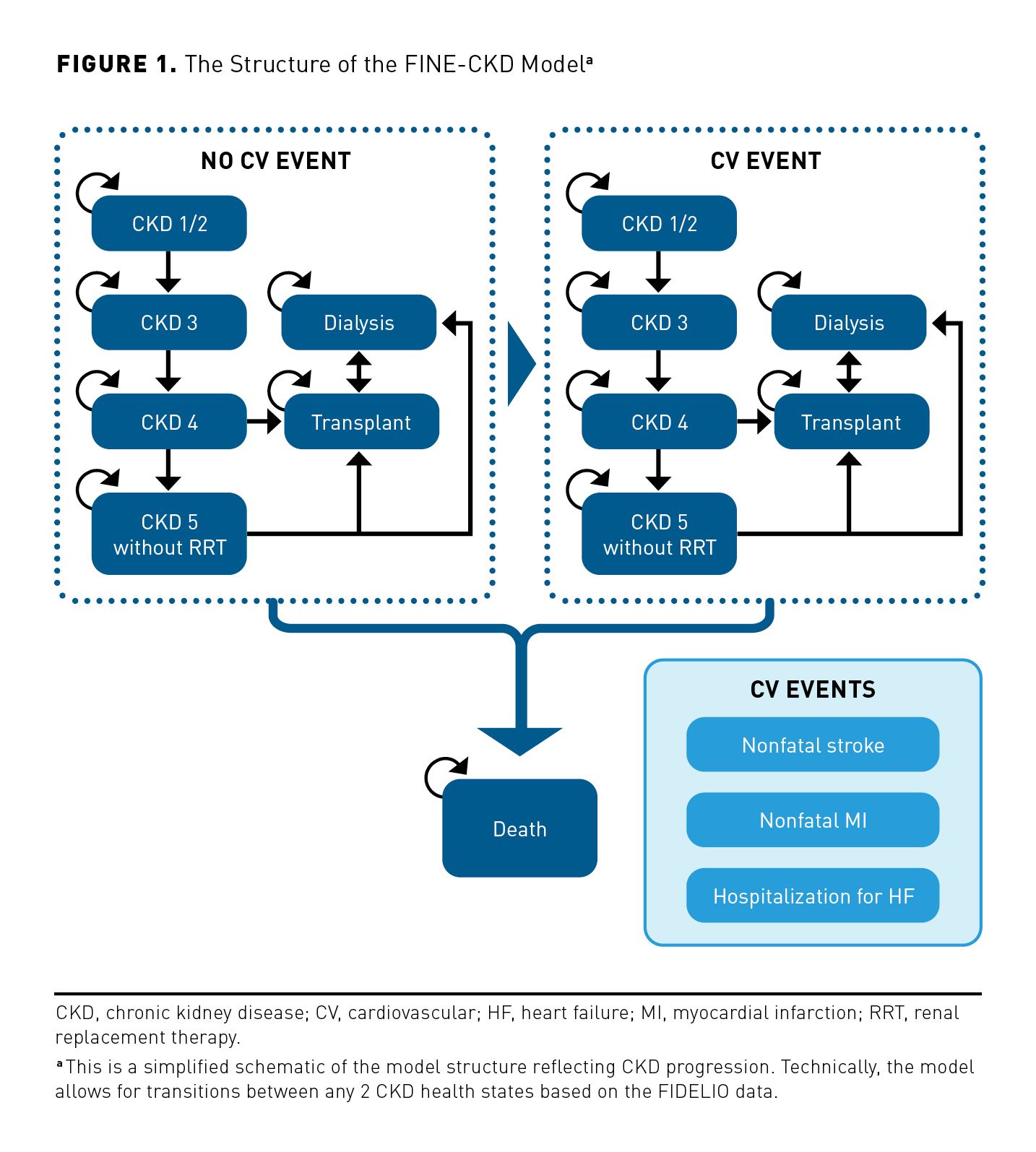
Model health states were defined according to the stage of CKD and history of CV events. Four stages of CKD, defined according to the estimated glomerular filtration rate (eGFR) as per the KDIGO guidelines, were considered: CKD stage 1/2, CKD stage 3, CKD stage 4, and CKD stage 5 without renal replacement therapy (RRT). Additionally, 2 stages of ESKD were considered: dialysis and transplant. Patients could start the model in 1 of the CKD stages without CV events. Patients could remain in the same CKD stage or move to more/less advanced CKD stages and/or experience a first modeled CV event (nonfatal myocardial infarction, nonfatal stroke, hospitalization for heart failure) or death.
Patients’ characteristics, probabilities of a first modeled CV event, other nonfatal and fatal events, and CKD progression for the BT arm were modeled based upon events observed in the placebo group of the FIDELITY analysis. BT probabilities were varied between CKD stages and computed as an average rate per 4-month cycle to align with the cycle length used in the FINE-CKD model. Hazard ratios (HRs) concerning treatment efficacy of finerenone together with BT relative to BT alone were calculated based on FIDELITY data for a range of outcomes comprising onset of eGFR decrease to less than 15 mL/min, progression to dialysis, CV mortality, renal mortality, first and subsequent CV events, hyperkalemia, sustained eGFR decrease of at least 40% from baseline, and new onset of atrial fibrillation/atrial flutter. Each of these was defined according to FIDELITY. These HRs then were used to determine probabilities for the finerenone arm.
External Validation With the FIDELITY Analysis
The objective of the external validation was to test the reliability of the model by ensuring alignment between the outcomes predicted by the model and the FIDELITY results. The incidence of first modeled CV events and CV deaths, as well as the number of patients undergoing dialysis, were compared with those of the model predictions. For each of the outcomes, a Kaplan-Meier curve of the observed cumulative event-free survival (EFS) was plotted against a cumulative EFS curve generated by the predictions of the model.
To test the null hypothesis of no difference between observed and predicted survival curves, Guyot’s algorithm9 was used to produce patient-level data from survival probabilities given by the model. To assess whether the modeled survival coincided with that observed in FIDELITY, investigators performed these statistical tests:
- log-rank test (using tests from survival and coin packages in R statistical software version 4.2.0),13 and the
- Gehan-Breslow test
External Validation With Existing Economic Models for CKD
Development of the FINE-CKD model was supported with a systematic literature review of existing economic models for CKD.12 Comparison of the FINE-CKD model with other published economic evaluations was performed. The objective of the cross-validation was to understand whether the FINE-CKD model is similar in terms of methodological approach, inputs, and outcomes. Two of the main challenges encountered during the cross-validation were the different model structures and the underlying assumptions; in addition, there was insufficient published information to align the base case or to compare results with the FINE-CKD model. Overall, the challenges meant that most identified models could not be sufficiently harmonized to adequately perform a validation check. The exception was the SHARP CKD-CVD model, a Markov model described by Schlackow et al.14 For cross-validation purposes, however, the online version of the SHARP CKD-CVD model was used. This was appropriate, because the publication did not present results for T2D patients, the population for whom finerenone is indicated.
In the SHARP CKD-CVD model, transitions between CKD stages, individualized renal and CV events, and CVD risks were estimated using 5-year follow-up data of the 9270 patients with CKD in the SHARP dataset and multivariate parametric survival analysis. The model includes a CKD submodel that simulates progression of CKD and a CVD submodel that simulates experience of fatal and nonfatal CV events and nonvascular death. A cohort simulation with annual cycles was used to evaluate the outcomes. Modeling focused on CV events and CKD progression according to patient history. Albuminuria was identified as a predictor of CKD progression and had an impact on the risk of CV events; however, as in the case of the FINE-CKD model, it was not explicitly included in the model structure. Health states considered by the model were CKD stage 3B, CKD stage 4, ESKD, need for dialysis, kidney transplant, CV events, and death.
For each participant, the annual risk of CV events was estimated in the SHARP CKD-CVD model using survival risk equations with a range of baseline characteristics. Age, time since CKD diagnosis, CVD history, and CKD status were updated annually. In each year, participants not on RRT could progress to, or remain in, any CKD category; transition probabilities were estimated using multivariate multinomial logistic regression. For participants on dialysis, the probability of receiving a kidney transplant was estimated using logistic regression.
As stated by the authors, the SHARP CKD-CVD model was validated internally, in several external datasets, and against existing risk scores.
The following clinical outcomes were chosen for the comparison: CV events or CV death, CV death, and initiation of RRT (dialysis and transplantation). Differences in outcomes were defined between models (Figure 2).

For cross-validation purposes, the patient baseline characteristics from FIDELTY were entered into the SHARP CKD-CVD model. When there were no data available from FIDELITY, default values from the SHARP CKD-CVD model were used. It was not possible to source all the parameters needed for the SHARP CKD-CVD model from data available in FIDELITY. For the validation, we reported results as the base case value, with ranges corresponding to minimum and maximum values of each outcome that could be obtained in the SHARP CKD-CVD model after checking all possible values for the model’s parameters (Table 1).
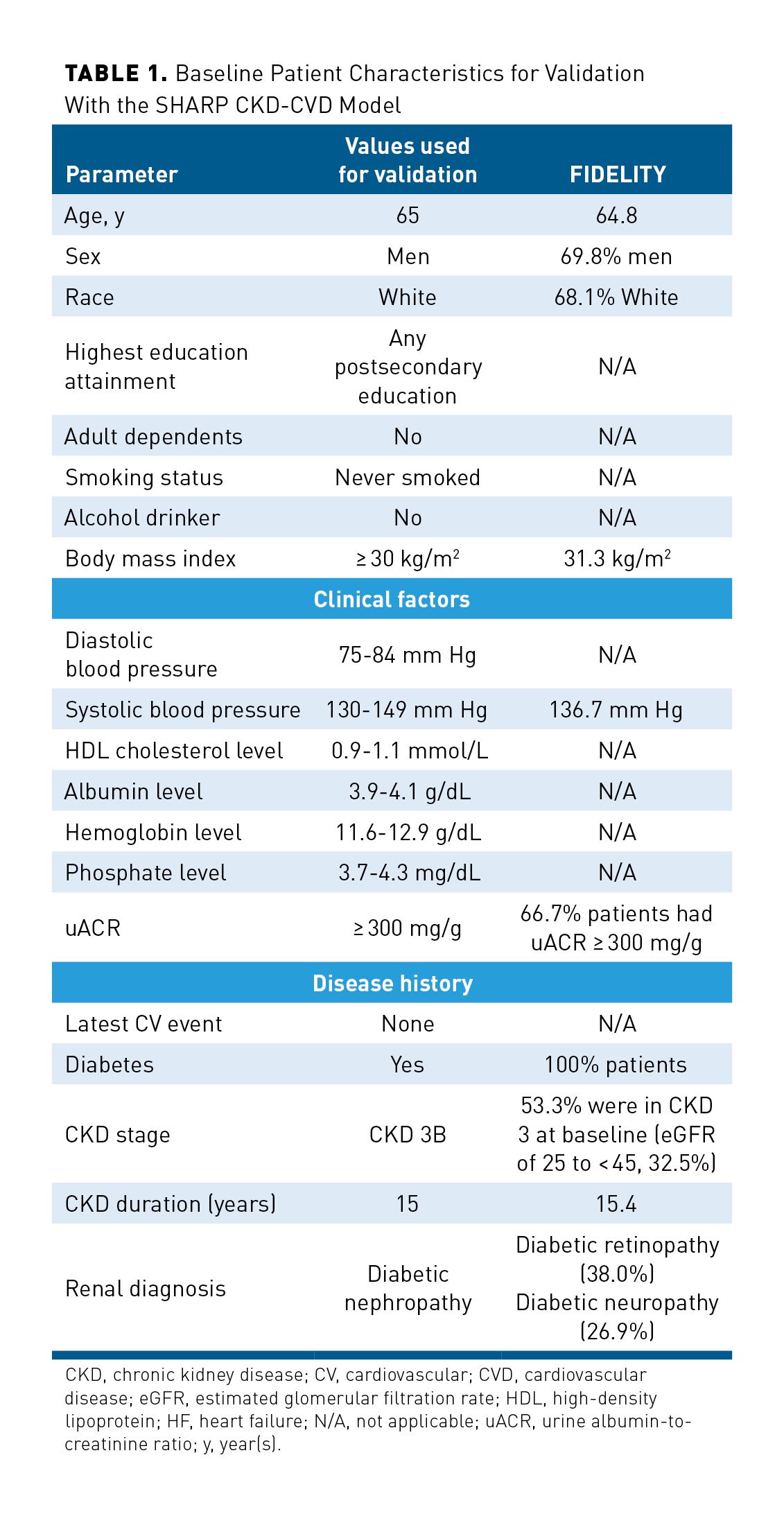
For the purposes of this validation, the results of the FINE-CKD model were presented as cumulative event probabilities (of major CV event or CV death, initiation of RRT, and CV death) per 1000 participants at the end of years 5 and 10. These were calculated using the Kaplan-Meier product.
The results of 2 models with different inputs were compared considering the ranges of estimates that could be obtained using the SHARP CKD-CVD model and confidence intervals (CIs) from the probabilistic sensitivity analysis run in the FINE-DKD model.
Results
External Validation With the FIDELITY Analysis
The outcomes predicted by the FINE-CKD model reflect the incidence of the first modeled CV event observed in the FIDELITY trial. The model estimations for BT are within the range of the FIDELITY CIs (Figure 3). Similar findings have been obtained for model estimates of CV deaths (Figure 4) as well as the number of patients starting dialysis (Figure 5). The outcomes of the FINE-CKD model for the time to first modeled CV event (Figure 6), CV death (Figure 7), and the start of dialysis (Figure 8) for finerenone plus BT vs BT alone correspond well with the observations from the FIDELITY analysis. This is further supported by the CIs that are determined by applying the lower and higher bounds of the HRs of FIDELITY to the probabilities used in the model; they also align with the CIs sourced directly from the event frequencies in the study. Based on the results of the statistical tests, the null hypothesis of no difference between observed and modeled curves cannot be rejected. The estimated P values are presented in the Table 2.
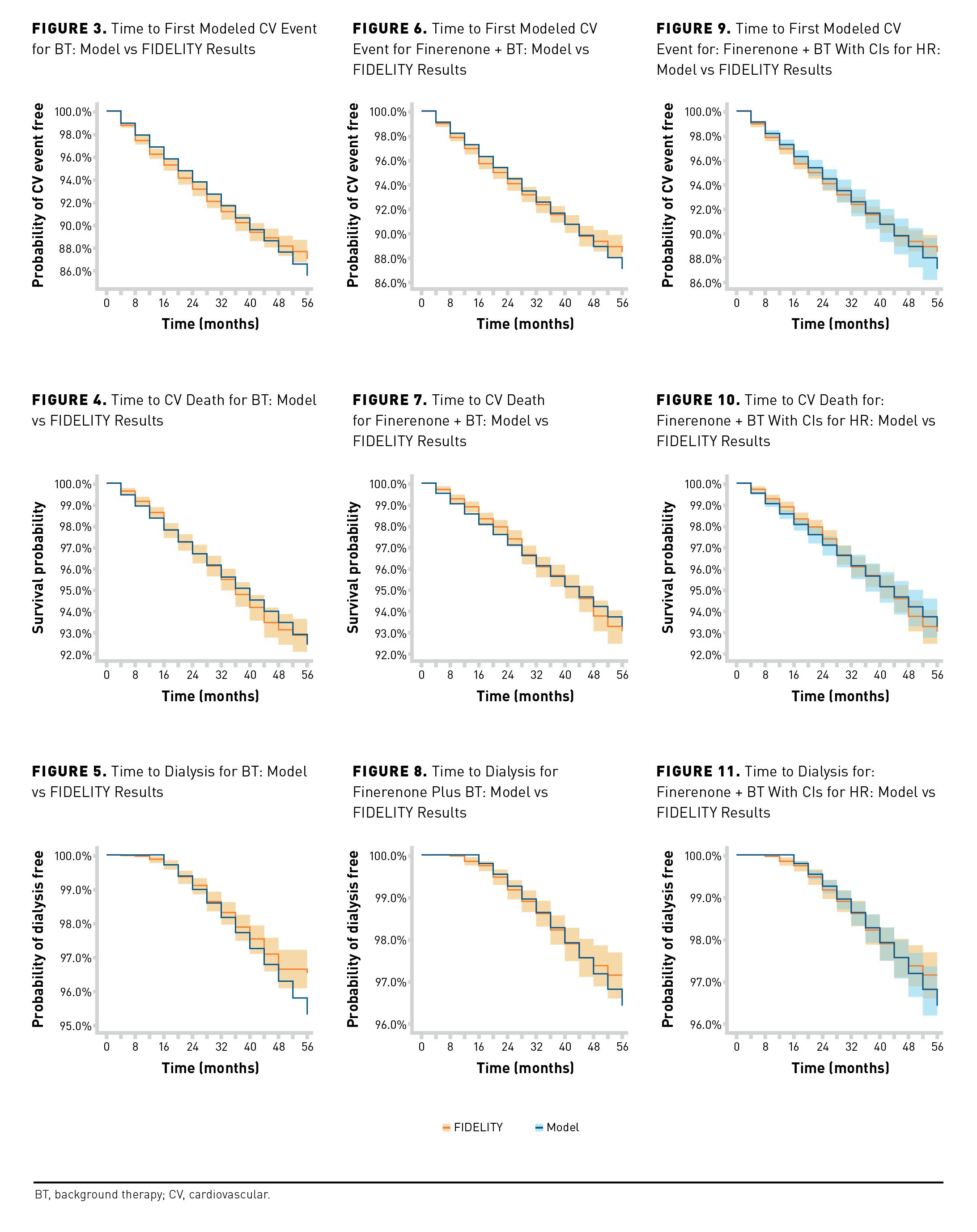
As reflected in the FIDELITY analysis, there were no observations of patients initiating dialysis within the first year of either FIDELIO-DKD or FIGARO-DKD. In the FINE-CKD model, the per-cycle rate of dialysis was calculated as an average across the entire follow-up of the FIDELITY analysis; this was consistent with the approach used involving all transition probabilities in the Markov model. However, to better reflect the reality of FIDELITY, FINE-CKD was able to omit transitions to dialysis for up to 1 year from the start of the model. The validation results reported here were generated assuming no dialysis in the model in the first year.
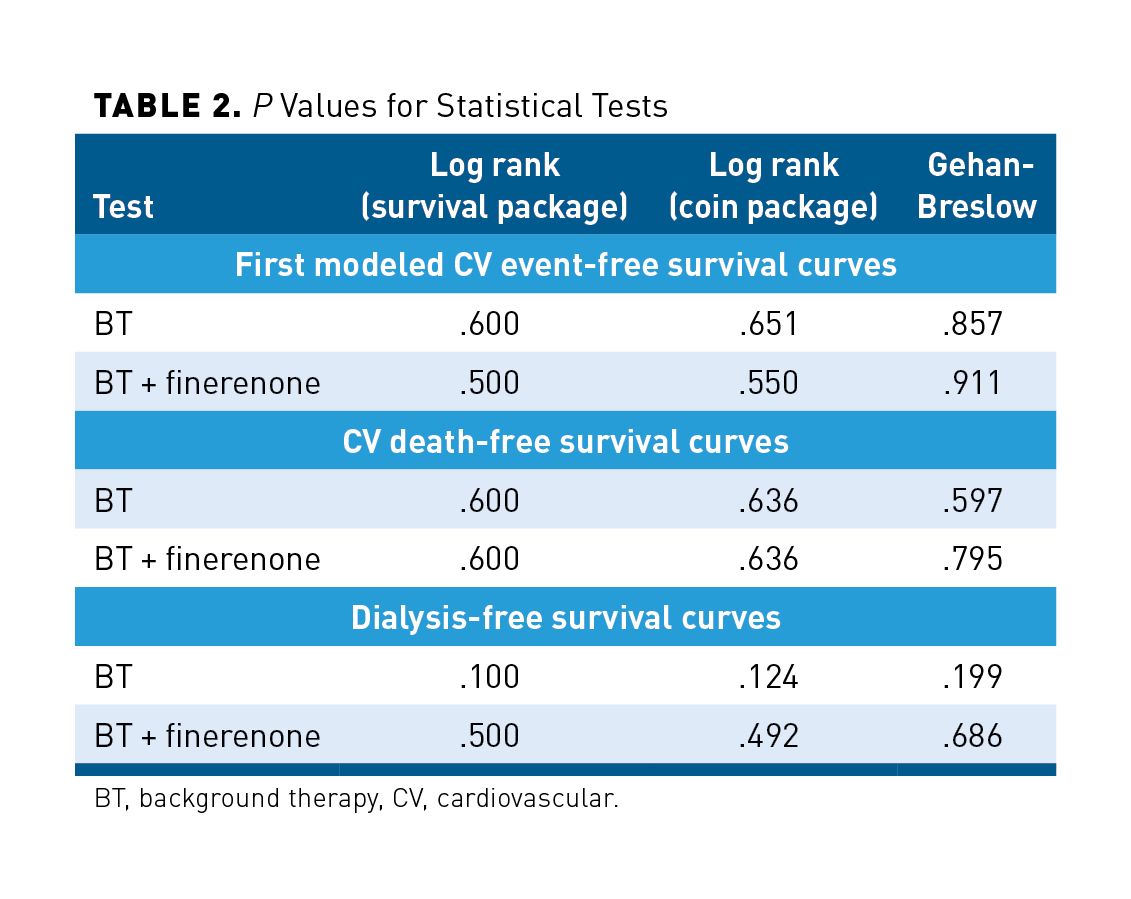
External Validation With Existing Economic Models for CKD
Results of the comparison with the SHARP CKD-CVD model are presented in Table 3 for patients given standard of care alone (ie, BT arm in the FINE-CKD model).
CKD progression and CV events were assessed in the SHARP CKD-CVD model using risk equations, and they varied in each cycle; therefore, ranges for the estimates were generated using validation of base case inputs and testing of the following parameters:
- smoking status (current smoker, former smoker)
- body mass index (BMI) (25-29 kg/m2)
- albumin level (< 3.9 or ≥ 4.2 g/dL)
- hemoglobin level (< 11.6 or ≥ 13 g/dL)
- phosphate level (< 3.7 or ≥ 4.6 mg/dL)
- urine albumin-to-creatinine ratio (< 30 or 30-300 mg/g)
- renal diagnosis (other known or unknown cause)
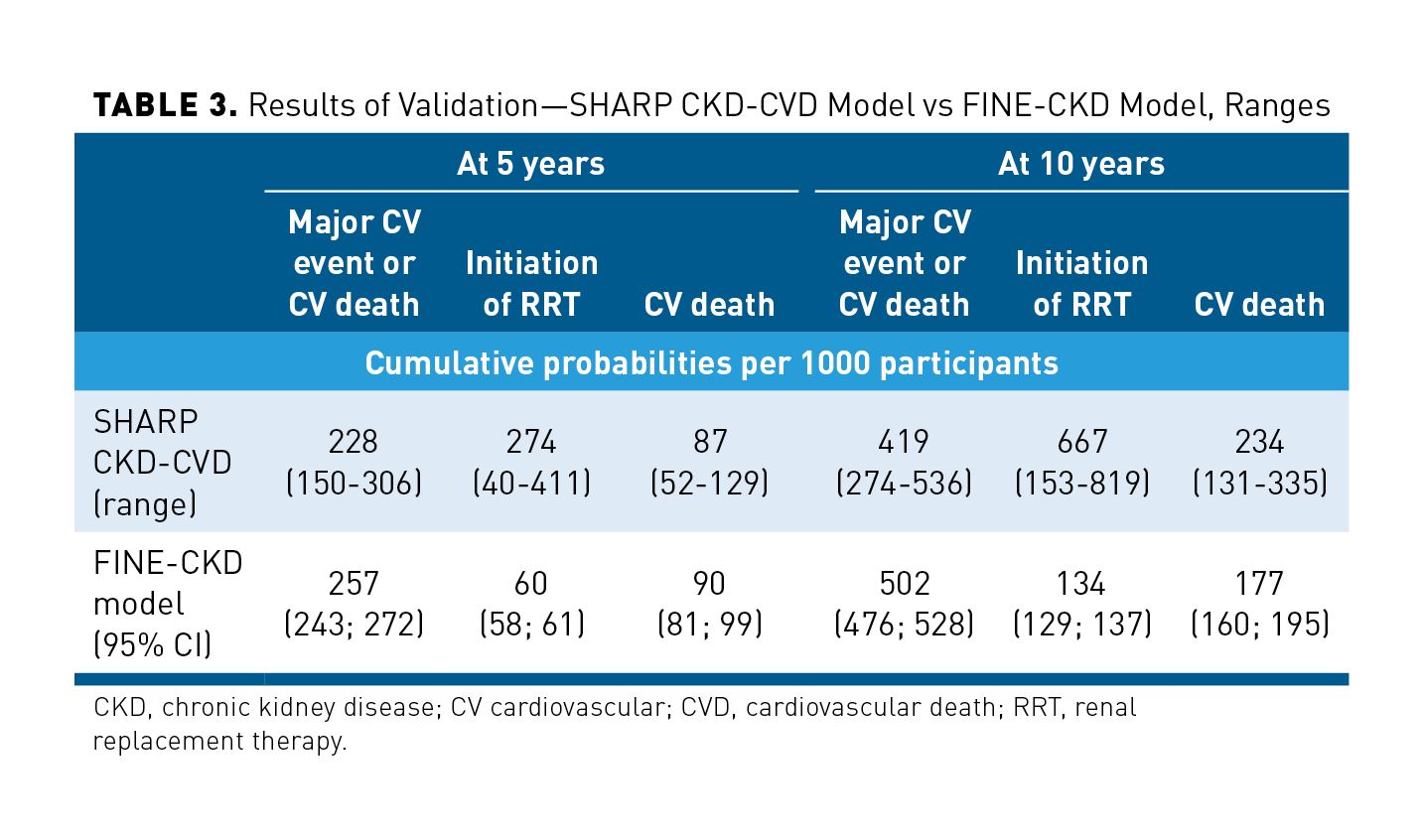
Note that, although they are similar in structure, differences exist between the SHARP CKD-CVD model and the FINE-CKD model. The SHARP CKD-CVD model restricts health states to CKD stage G3b onwards, whereas the FINE-CKD model also includes health states for those with mild CKD in stages G1/2 and G3a. Inclusion of patients with more advanced CKD in the SHARP CKD-CVD model partially explains the higher incidence of RRT events in this model, as shown in the results of the analyses undertaken which considered ranges from the SHARP CKD-CVD model. For example, analyzing patients with A2 uACR level (30-300 mg/g) in the SHARP CKD-CVD model reduces the cumulative probability of RRT initiation to 93 per 1000 participants at 5 years and 324 at 10 years as shown in Table 4. These estimates were very close to outcomes from the FINE-CKD model. Other examples of parameters impacting estimates of SHARP CKD-CVD and that could not be fully adjusted to the FIDELITY analysis population are presented in Table 4.
The results of the FINE-CKD model are within the ranges that can be obtained from the SHARP CKD-CVD model, as seen in Table 3. Overall, the clinical progression modeled in the FINE-CKD model appears aligned with the results of the SHARP CKD-CVD model.
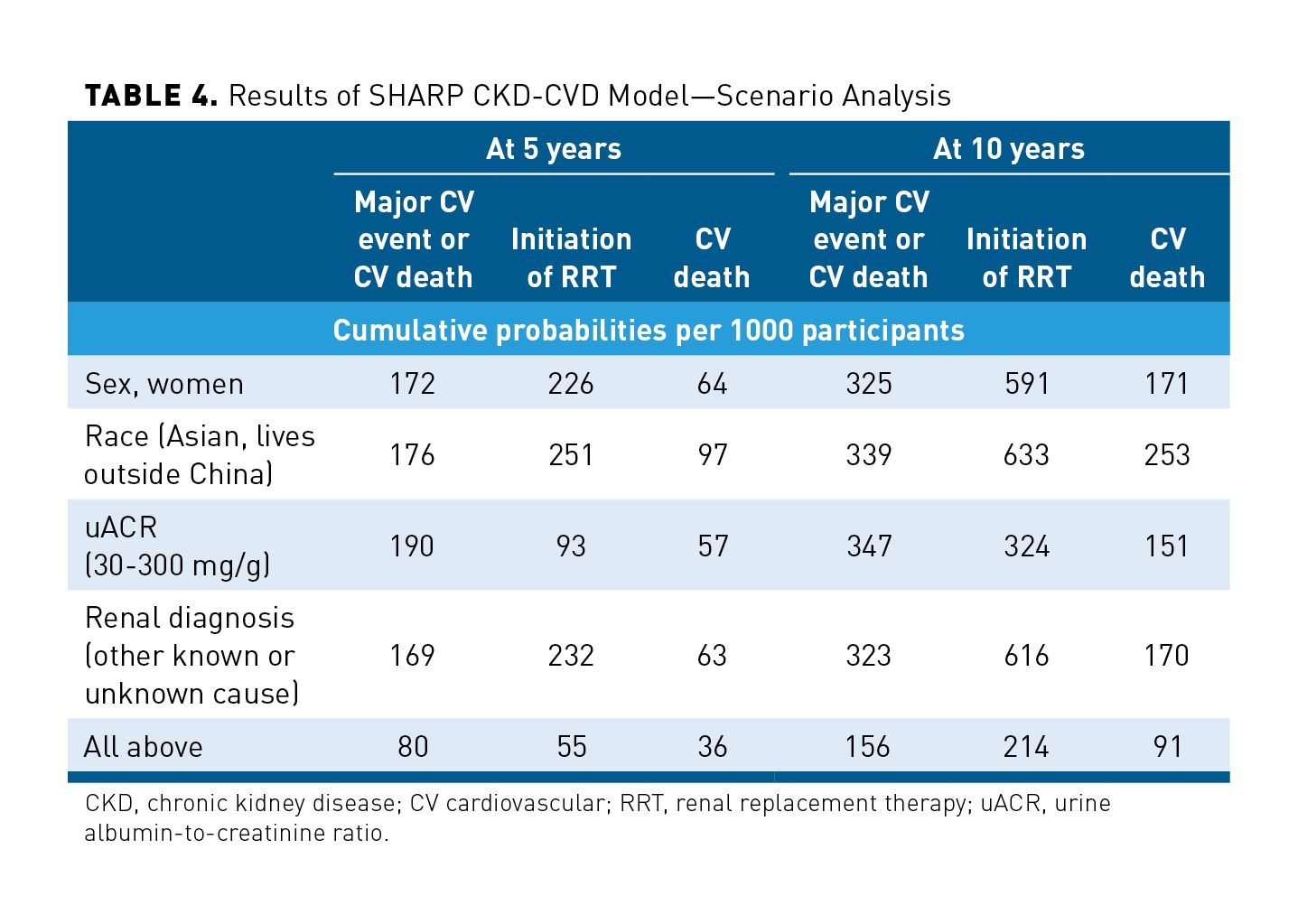
Discussion
The FINE-CKD model was developed based on the findings of a systematic literature review. It is consistent with other models in this area. Following good practices renders the model transparent and reduces the uncertainty related to unnecessary complexity. The application of a Markov framework appropriately allows for evaluation of the cost-effectiveness of finerenone in patients with CKD associated with T2D. The authors of the present study acted as a steering committee of clinical and health economic experts, who oversaw and guided the development of this model, as well as confirmed and validated the model methodology and all inputs and assumptions. Reliability of the model was verified by comparing predicted outcomes of the model against those of the trial data used to develop the model (ie, the FIDELITY analysis) and cross-validation with the SHARP CKD-CVD model.
This validation exercise demonstrated concurrence between the results of the model and of the FIDELITY analysis using standard statistical tests. Although the model slightly overestimated the incidence of dialysis in the BT arm during the study follow-up, the cumulative modeled incidence of dialysis aligned well with the results of FIDELITY analysis after 4 years. The discrepancy in the initial phase could be explained by the absence of dialysis cases in the first year of the FIDELITY analysis. This characteristic of the FIDELITY analysis could be addressed through a scenario available in the FINE-CKD model, whereby dialysis was only possible after a specified period.
This study has a number of limitations. Although adequate modeling of the impact of finerenone on CKD outcomes is inherently complex, a range of simplifications were applied, including omission of including albuminuria as a modelled health state. These simplifications have been undertaken in the FINE-CKD model for practical reasons, and their impact on model results was assessed via sensitivity or subgroup analysis. None of the simplifications applied hindered the ability to determine the cost-effectiveness of finerenone in this indication. Differences in both model structure and underlying assumptions, along with published information that proved insufficient for alignment with the models’ base case or adequate comparison of results, made cross-validation with other published models challenging. Nonetheless, the FINE-CKD model was compared with the SHARP CKD-CVD model due to the online availability of version of the latter, which specifically considered a subgroup of patients with T2D.
The SHARP CKD-CVD model was highly flexible, but differences complicated the ability to obtain the same results as in FINE-CKD for some outcomes. For example, the SHARP CKD-CVD model predicted higher incidence of renal events. This indicates that the FINE-CKD model estimates are more conservative from a cost-effectiveness perspective, because a higher baseline risk of such events with an advantageous treatment benefit relative to standard of care would translate into a greater scope to offer value through treatment.
In general, however, the clinical progression modeled by the FINE-CKD model appears to be well-aligned with the results of the SHARP CKD-CVD model. The alignment was more precise for CV outcomes, although the number of patients estimated to start RRT by the FINE-CKD model was within the possible ranges of scenario analyses using the SHARP CKD-CVD model.
Despite the positive results of the cross-validation, some uncertainty remains, as shown by the SHARP CKD-CVD model yielding wide ranges and being the only identified model sufficient for cross-validation. Nevertheless, the results of the FINE-CKD model are at the lower end of the reference range in terms of initiation of RRT. Estimates of the FINE-CKD model, therefore, can be considered conservative in the context of the model being used for cost-effectiveness assessment.
Conclusions
Following recommendations from ISPOR, a model should be declared “valid” only in the context of its future applications.15 The FINE-CKD model is the first de novo model deemed suitable for future health technology assessments of finerenone in patients with CKD associated with T2D. In this context, the most important requirements of the model are transparency and an ability to adequately reflect the available clinical data. Together, these provide a basis for reliable extrapolation relative to the existing predictive tools.
The results of this study demonstrated that the FINE-CKD model meets these requirements, as it uses a potentially conservative approach. Nevertheless, in the case of any model, some level of uncertainty remains—and FINE-CKD is not an exception. This uncertainty must be addressed in future health technology assessments via a comprehensive and exhaustive set of scenario and sensitivity analyses.15
Acknowledgements
Author Affiliations: Bayer AG (KF), Wuppertal, Germany; Bayer AG (PM), Berlin, Germany; CHOICE Institute and University of Washington (SDS), Seattle WA; Creativ-Ceutical S.À R.L. (MPo, AD, MPa,), Kraków, Poland; Creativ-Ceutical S.À R.L. (AM), Paris, France; Université Paris-Dauphine and PSL University (PL), Paris, France; University of Toronto and Nephrologist University Health Network (DC), Toronto, Canada; University of Cambridge (SM), Cambridge, United Kingdom; Salisbury VA Medical Center (PRC), Salisbury NC.
Funding Source: This work was supported by Bayer AG.
Author Disclosures: Dr Roy-Chaudhury reports serving on a consultancy or paid advisory board for Akebia, Bayer, Cormedix, Humacyte, WL Gore, BD, Medtronic, and Vifor. He is also the Chief Scientific Officer and founder of Inovasc LLC. Dr Cherney has received honoraria from Boehringer Ingelheim-Lilly, Merck, AstraZeneca, Sanofi, Mitsubishi-Tanabe, Abbvie, Janssen, Bayer, Prometic, BMS, Maze, Gilead, CSL-Behring, Otsuka, Novartis, Yeungene and Novo-Nordisk; Operational funding for clinical trials from Boehringer Ingelheim-Lilly, Merck, Janssen, Sanofi, AstraZeneca, CSL-Behring and Novo-Nordisk. Dr Levy and Dr Sullivan report serving as a consultant or paid advisory board for Bayer. Mernagh and Folkerts are employed by, own stock in, and report an institutional conflict of interest with Bayer AG, such as US and EU approval of a product for chronic kidney disease in type 2 diabetes. Dr Millier and Dr Pochopień report an institutional conflict of interest with Creativ-Ceutical S.À R.L, which received fees from Bayer AG for this work. Dr Morris has received honoraria from Bayer AG. Drzewiecka and Palarczyk report no relationship or financial interest with any entity that would pose a conflict of interest with the subject matter of this article.
Authorship Information: Concept and design (MPo, DC, KF, PL, SM, PRC, SDS); acquisition of data (MPo, AD, MPa); analysis and interpretation of data (MPo, DC, AD, KF, PL, AM, SM, MPa, PRC, SDS, PM); drafting of the manuscript (MPo, AD, MPa, PM); critical revision of the manuscript for important intellectual content (DC, KF, PL, AM, SM, PRC, SDS, PM); statistical analysis (MPo, AD, MPa); administrative, technical, or logistic support (AM); and supervision (MPo, PRC, SDS).
Address Correspondence to: Michał Pochopień, MSc, Przemysłowa 12, 30-701 Kraków, Poland. E-mail: michal.pochopien@creativ-ceutical.com
References
1. Sasso FC, Chiodini P, Carbonara O, et al. High cardiovascular risk in patients with type 2 diabetic nephropathy: the predictive role of albuminuria and glomerular filtration rate. The NID-2 Prospective Cohort Study. Nephrol Dial Transplant. 2012;27(6):2269-2274. doi:10.1093/ndt/gfr644.
2. System USRD. 2018 USRDS Annual Data Report: Epidemiology of Kidney Disease in the United States. Bethesda, MD: National Institutes of Health, National Institute of Diabetes and Digestive and Kidney Diseases, 2018.
3. Afkarian M, Sachs MC, Kestenbaum B, et al. Kidney disease and increased mortality risk in type 2 diabetes. J Am Soc Nephrol. 2013;24(2):302-308. doi:10.1681/ASN.2012070718
4. Valderrábano F, Jofre R, López-Gómez JM. Quality of life in end-stage renal disease patients. Am J Kidney Dis. 2001;38(3):443-464. doi:10.1053/ajkd.2001.26824
5. Kidney Disease: Improving Global Outcomes (KDIGO) CKD-MBD Update Work Group. KDIGO 2017 Clinical Practice Guideline Update for the Diagnosis, Evaluation, Prevention, and Treatment of Chronic Kidney Disease-Mineral and Bone Disorder (CKD-MBD). Kidney Int Suppl (2011). 2017;7(1):1-59. doi:10.1016/j.kisu.2017.04.00. Correction appears in: Kidney Int Suppl (2011). 2017;7(3):e1.
6. National Kidney Foundation. KDOQI Clinical Practice Guideline for Diabetes and CKD: 2012 Update. Am J Kidney Dis. 2012;60(5):850-886. doi:10.1053/j.ajkd.2012.07.005. Correction appears in Am J Kidney Dis. 2013;61(6):1049.
7. American Diabetes Association Professional Practice Committee, Draznin B, Aroda VR, et al. 11. chronic kidney disease and risk management: standards of medical care in diabetes-2022. Diabetes Care. 2022;45(suppl 1):S175-S184. doi:10.2337/dc22-S011. Correction appears in Diabetes Care. 2022;45(3):758.
8. Evans M, Lewis RD, Morgan AR, et al. A narrative review of chronic kidney disease in clinical practice: current challenges and future perspectives. Adv Ther. 2022;39(1):33-43. doi: 10.1007/s12325-021-01927-z
9. Bakris GL, Agarwal R, Anker SD, et al. Design and baseline characteristics of the finerenone in reducing kidney failure and disease progression in diabetic kidney disease trial. Am J Nephrol. 2019;50(5):333-344. doi:10.1159/000503713
10. Ruilope LM, Agarwal R, Anker SD, et al. Design and baseline characteristics of the finerenone in reducing cardiovascular mortality and morbidity in diabetic kidney disease trial. Am J Nephrol. 2019;50(5):345-356. doi:10.1159/000503712
11. Agarwal R, Filippatos G, Pitt B, et al. Cardiovascular and kidney outcomes with finerenone in patients with type 2 diabetes and chronic kidney disease: the FIDELITY pooled analysis. Eur Heart J. 2022;43(6):474-484. doi:10.1093/eurheartj/ehab777. Published correction appears in Eur Heart J. 2022;43(20):1989.
12. Pochopien MT, Cherney DZI, Folkerts K, et al. FINE-CKD model to evaluate economic value of finerenone in patients with chronic kidney disease and type 2 diabetes. Am J Manag Care. 2021;27(suppl 20):S375-S382. doi:10.37765/ajmc.2021.88808
13. The Comprehensive R Archive Network. Accessed June 23, 2022. https://cran.r-project.org
14. Schlackow I, Kent S, Herrington W, et al. A policy model of cardiovascular disease in moderate-to-advanced chronic kidney disease. Heart. 2017;103(23):1880-1890. doi:10.1136/heartjnl-2016-310970.
15. Eddy DM, Hollingworth W, Caro JJ, et al. Model transparency and validation: a report of the ISPOR-SMDM Modeling Good Research Practices Task Force-7. Med Decis Making. 2012;32(5):733-743. doi:10.1177/0272989X12454579.
